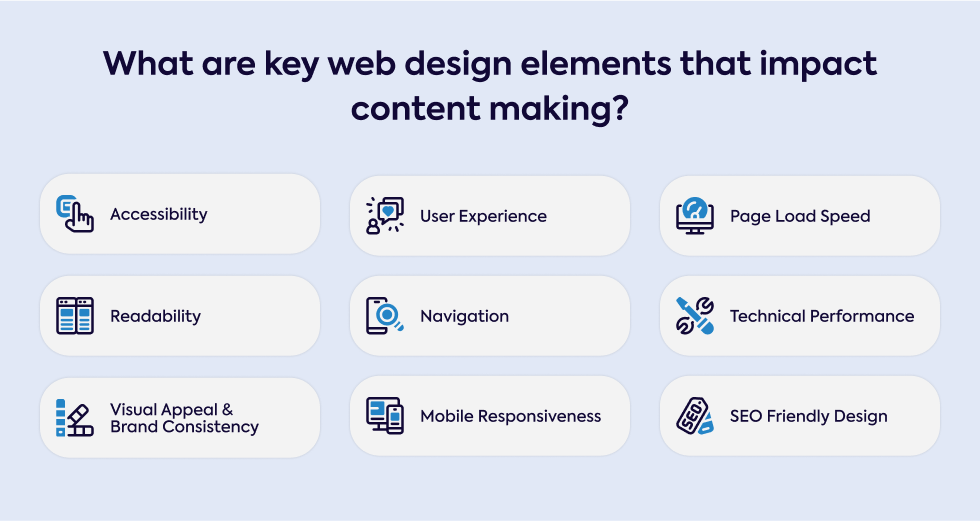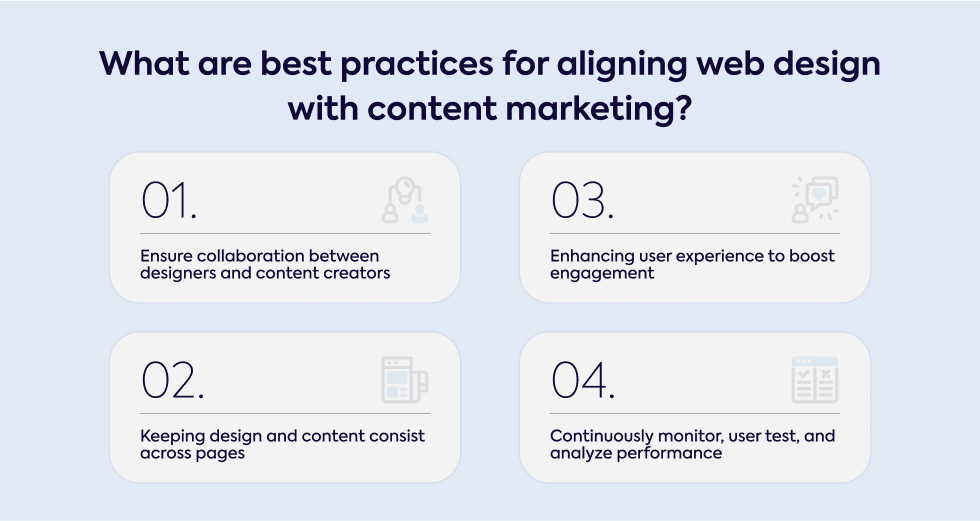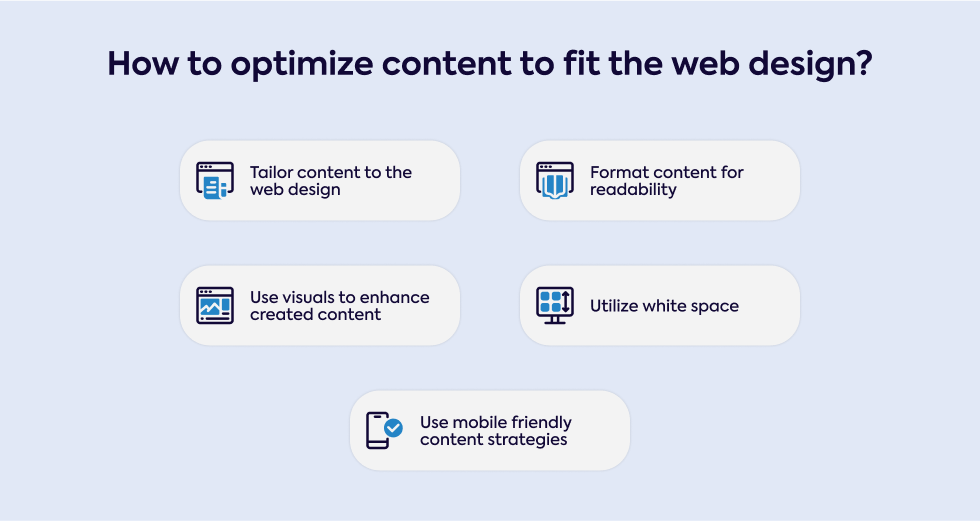Key Takeaways
- Design plays a crucial role in how well your audience interacts with content, impacting readability, navigation, and overall user experience.
- A clean, visually appealing layout with good use of white space improves engagement, making it easier for users to find and focus on helpful content.
- Key elements of web design such as accessibility, mobile responsiveness, and fast page load speed are essential for keeping users on your site longer and enhancing SEO performance.
- Consistency in the design of your website strengthens brand identity, builds trust, and boosts conversions through well-placed CTAs.
- Collaboration between designers and content creators ensures that design trends and content align, creating a seamless user experience that supports your marketing goals.
What is Content Marketing?

Content marketing is a key part of any digital marketing strategy, and it involves creating and sharing valuable content that appeals to your audience.
Instead of directly promoting your products or services, content marketing focuses on offering relevant content that helps build interest and trust in your brand.
This approach aligns with your overall marketing goals and ensures you engage your audience in a meaningful way.
A well-planned content marketing strategy helps you establish expertise in your field and keep your audience engaged over time.
It also plays a big role in SEO (search engine optimization), helping your website rank higher in search engines.
This not only boosts visibility but can also lead to better marketing outcomes, such as increased traffic and customer loyalty.
So, How Does Web Design Impact Content Marketing?
The connection between web design and content marketing is stronger than you might think. Your web designer plays a huge role in shaping how your audience interacts with your content. Web design impacts content marketing by influencing readability, navigation, and user experience.
Good design improves how well your audience engages with your content.
A clean layout enhances readability and encourages visitors to explore your web page more thoroughly.
Design elements like white space and font choice can help keep users focused, while a well-designed site also enhances content by making it more engaging and easier to digest.
Ultimately, the way web design on content marketing is executed can directly impact user behavior, boosting engagement and helping your marketing efforts succeed.
Key Web Design Elements That Impact Content Marketing

Accessibility
Design principles in web design ensure your content is accessible to everyone, regardless of their abilities.
Simple things like a navigation setup with drop-down menu options and a clear layout make it easier for all users to find what they’re looking for.
When users can easily navigate, they have a more positive user experience, which is essential.
Your website must also adapt to different screen sizes and devices to ensure that users can access content without any barriers.
This inclusive approach keeps users engaged and encourages them to explore more of your site.
Readability and Scannability
Clear and well-chosen font styles and sizes are essential for readability.
Breaking content into sections with headings, subheadings, and shorter paragraphs creates a better visual hierarchy and makes content easier to process.
A clean design not only looks good but also makes it easier for users to find the information they need quickly.
Visual Appeal and Brand Consistency
Maintaining a strong brand identity through consistent use of typography, colors, and layouts is key.
This consistency reinforces who you are as a brand and strengthens the overall experience.
A well-designed website enhances trust and credibility, making your audience more likely to engage with your content.
Moreover, using bold elements or colors strategically can direct attention to important calls-to-action (CTAs) and encourage conversions.
User Experience (UX) and Navigation
A good user experience is fundamental to effective content marketing.
A well-thought-out navigation system that can guide users intuitively through your site ensures that they can find the content they need without frustration.
This seamless navigation leads to a seamless user experience, helping to keep users engaged and moving through your content effortlessly.
Mobile Responsiveness and Device Compatibility
A website with responsive design guarantees your site adapts to any device, whether it’s a desktop, tablet, or smartphone.
A responsive web design ensures that the user experience is optimized no matter the device, offering a consistent experience across all platforms.
With mobile usage on the rise, your site must work well on mobile devices; otherwise, you risk losing visitors and experiencing higher bounce rates.
Page Load Speed and Technical Performance
Fast page load speed is crucial for keeping users on your site.
Slow load times not only frustrate users but can also negatively affect your SEO efforts.
Improving your site’s technical performance through optimizing images and reducing unnecessary code can help avoid performance issues that impact both user experience and search rankings.
SEO-Friendly Design
The structure of your website directly affects your ranking on search engines.
Following SEO-friendly design principles, such as clear site navigation and optimized content, improves your visibility on search engine results pages.
Incorporating alt text for images, meta tags, and responsive design ensures that your site ranks higher and attracts more visitors.
Best Practices for Aligning Web Design with Content Marketing

Collaboration Between Designers and Content Creators
Successful projects depend on collaboration between designers and content creators.
Each team brings a different perspective that is vital to delivering a cohesive experience.
Design decisions should complement your content marketing efforts, ensuring that the visual elements support the message you're trying to convey.
Consistency Across Pages
Consistency is crucial when it comes to design elements.
Using the same colors, fonts, and layouts across all pages not only enhances content but also ensures that the reflection of your brand remains clear and recognizable.
When everything aligns, users have a seamless experience that builds trust and encourages further engagement.
Enhancing User Experience to Boost Engagement
A user-friendly website design encourages visitors to stick around.
When users find a site that is easy to navigate, they are more likely to stay and explore.
A poor design, on the other hand, can drive visitors away.
Creating a layout that’s intuitive and clutter-free keeps visitors on your site longer and boosts engagement.
Continuous Monitoring, User Testing, and Analytics
To ensure your website continues to perform well, regular user testing and analysis of site performance are important.
Analytics can provide insights into how visitors are interacting with your content, while A/B testing allows you to refine your approach.
This ongoing optimization helps you adjust design and content to improve the user experience.
Optimizing Content for Web Design

Tailoring Content to the Design
When it comes to content marketing and web design, it's important to make sure your content fits seamlessly within the design of the site.
Tailored content that works with the overall design structure enhances the user experience and makes your message clearer.
Thoughtful design allows content to flow smoothly and be consumed effortlessly.
Formatting for Readability
Using negative space around text, short paragraphs, and clear fonts makes your content more readable.
Breaking up text with bullet points and subheadings also helps users easily scan and find key information.
A logical, well-organized structure improves both comprehension and engagement.
Using Visuals to Enhance Content
Incorporating visual content, such as video content or infographics, can greatly increase engagement.
These visuals help explain complex information in a simple way and can boost user interaction.
Using relevant multimedia ensures your content remains interesting and accessible.
Utilizing White Space
Effective use of white space—or negative space—can improve readability by making the page feel less cluttered.
A balanced layout helps users focus on the most important elements, and the clean look makes content more visually digestible.
This also reduces cognitive load, making your site easier to navigate.
Mobile-Friendly Content Strategies
A mobile-friendly approach is essential for today’s audience.
You can ensure mobile responsiveness by creating flexible layouts and shortening content for smaller screens.
Fast load times are especially important for mobile users, who are often quick to leave a site that doesn’t perform well.
With mobile-optimized buttons and CTAs, users can interact with your content easily, even on the go.
Designing a Content-Friendly Website: Tips for Success

Structuring Your Layout for Content
A clear structure with proper headings, logical flow, and a mix of visual elements will make your site easier to navigate.
Use of white space and well-placed sections breaks up text and helps users focus.
Your design layout should always prioritize readability and simplicity.
Enhancing Engagement Through Calls-to-Action (CTAs)
Strategically placed CTAs can encourage visitors to take action.
Ensure your CTAs stand out with contrasting colors or eye-catching design, and make them easy to find.
Clear and concise CTAs like “Sign Up” or “Learn More” help guide visitors toward conversions.
Incorporating Feedback and Continuous Improvement
Regular feedback from users is key to refining your website.
Use this input, along with user interaction data from analytics, to make iterative changes that keep improving the experience.
Continuous improvement ensures your site remains functional and engaging for the long term.
Ready to Elevate Your Content Marketing with Impactful Web Design?
At Gauss, we understand how design for effective content marketing can make or break your online success.
A well-structured, responsive website doesn’t just look good—it’s crucial to ensuring your audience engages with your content seamlessly.
Whether you need help with improving readability, enhancing SEO, or delivering an intuitive user experience, we’re here to help.
If you're looking to optimize your content marketing strategy and significantly impact your business growth, let’s talk.
Visit Gauss to start a conversation and discover how we can tailor a solution to your needs.
Get in touch now and let’s build something great together!
